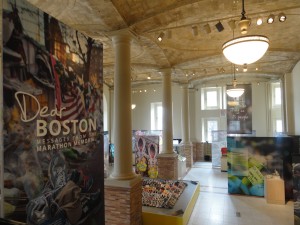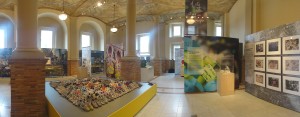In the wake of the terrible bombings at the Boston Marathon last year on April 15, and as part of my series of posts on the Empathetic Museum, I wrote with admiration about the ways in which Boston museums had rallied for their community. A week or so later I posted again , this time focusing on the reflections of Rainey Tisdale, a Boston museum blogger and curator who had written thoughtfully on the tragedy itself and on the role of museums in helping the community to heal. I quoted Rainey and then went on to comment on what an impossible task she had set for herself and for Boston:
Rainey said: Boston deserves a thoughtful, compelling, and flawlessly executed exhibition of this material (the mementos left on Copley Square) on the one-year anniversary of the bombings—to help Bostonians process their emotions and memories and transform them into some sort of positive civic engagement for the city.
And I responded: This is a remarkable statement. If there is one consistent thread I have found in years of writing and thinking about exhibitions on difficult topics in the museum journal Exhibitionist ( see “The Unexhibitable: A Conversation,” Fall 2008) and “Museums, Memorials, and Sites of Conscience,” Fall 2011), it is this: It usually takes a very long time–often many years–for the affected community to come to grips with a searing and traumatic event in such a way as to embody it in a building or an exhibition. For example, museum colleagues in Colorado have struggled for years to create some kind of meaningful exhibition about Columbine. The 9/11 Museum in New York has yet to open. If Boston can indeed complete such a task within a year it will be an important step, in my view, for museums everywhere. The reason is stated by Tisdale herself – it will help Bostonians (as well as all visitors, one would hope) to reflect, process, and heal in the direct aftermath. A museum or exhibition, with accompanying programs, that might actually emerge in such a timely fashion would be the best possible witness to the unique value of museums as public (physical and digital) spaces where communities can confront and remember difficult events in a safe, reflective, and communal manner–a true commons for Boston.
Well, they did it!
The exhibition Dear Boston: Messages from the Marathon Memorial, opened on April 7, 2014, at the Boston Public Library across from Copley Square where a makeshift memorial grew after the bombings. The exhibition will be on display until Sunday, May 11, 2014. It is the centerpiece of a larger effort called #BostonBetter, a collaboration among 25 Boston cultural institutions (listed on the #BostonBetter website) to offer programming for the anniversary. The webpage of #BostonBetter provides much more information than this brief blog about the exhibition and the broad array of programs– music, lectures, art activities, oral histories– organized throughout the Boston area this April. Although a funder came forward for the Dear Boston exhibition, the larger #BostonBetter project is unfunded; the 25 partner institutions are developing this programming from their own existing staff and operating budgets.
Curator Rainey Tisdale and her team put the Dear Boston exhibition together in about two months after a critical mass of supporters coalesced around the effort earlier this year. I talked with Rainey briefly the other day about the project. She is still processing its enormity and plans to write her own reflections once the anniversaries of the 2013 marathon (April 15), this year’s marathon (April 21), and the closing of the current exhibition are past and able to be seen together and in context. One of Rainey’s most interesting observations was that it was independent museum professionals in the Boston area who had the flexibility to address and complete a project with timeliness as one of its primary requirements. As Elaine Gurian and others have observed, timeliness is not museums’ strong suit. This may not have mattered so much in earlier, slower moving times; but in our fast paced society it is fair to ask whether there is an adverse impact on museums’ relevance and public value if they continue their glacial pace in response to deeply felt concerns in the communities they serve.
Rainey’s team–project manager Anne Starr, graphic designer Helen Riegle, concept planner Matt Kirchman, and interns Tiffany Locke and Emily Shafer—worked long days in February and March to create and install Dear Boston Key partners include:
- NEMA (the New England Museums Association), which worked with Rainey from the beginning, bringing other institutions to the table and also serving as the financial entity;
- The Boston Public Library, an important part of the civic community and adjacent to Copley Square. Its exhibition space was from the beginning judged to be the essential symbolic venue.
- Iron Mountain, a Boston-based international documents storage and management company, the sole sponsor of the exhibition, has also provided storage space to the
- Boston City Archives, repository and conservator for the thousands of documents and objects from the Copley Square makeshift memorial.
To overcome the considerable challenges of time, an emotionally wrenching and fraught subject, a variety of stakeholders and cultural institutions, and no existing structure to address this kind of event, Rainey says that the following elements were key:
- Creating an initial sense of trust among a small group of planners that grew as trust was rewarded and affirmed; this led to
- A critical mass of support and collaboration that spread throughout many layers of the city – city officials, directors of museums and other cultural institutions, survivors and families, community leaders, allowing the project to come to fruition.
Of course this sounds much too simple, and I look forward to Rainey’s thoughts about this complex and truly important experience. The lessons that emerge will no doubt have important consequences for our field and for the growth of the empathetic museum.
Rainey and her team hope that the exhibition provides multiple layers of remembrance, reflection, and healing for visitors, who will encounter objects, messages, and photographs representing three major themes. The themes coalesced as the team sorted and examined all of the materials from the makeshift memorial: the initial, widespread reaction to the bombings; attempts at processing and understanding what had happened; and expressions of hope and solidarity. At the end of the exhibition, visitors may place tags on live potted trees brought into the library. As with the trees of Copley Square, they provide a shelter and an invitation for visitors to leave their own thoughts and hopes regarding the Boston community and the world community.
To follow this project as it evolves over the coming weeks, check the #BostonBetter website and #BostonBetter and @BPLBoston on Twitter. The Boston Globe and NPR have already provided thoughtful coverage. Look for much more as the April 15 anniversary and the 2014 marathon itself approach. This is something the field should be looking at and talking about for a long time.
If this post is being sent to you by email and you would like to subscribe or add a comment, please click on Museum Commons . Thanks.

